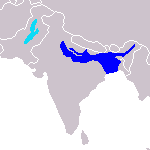Ganges and Indus River Dolphin
|
|
| Ganges and Indus River Dolphin Conservation status: Endangered | ||||||||||||||||||
|---|---|---|---|---|---|---|---|---|---|---|---|---|---|---|---|---|---|---|
 Ganges River Dolphin Photographer:Brian D. Smith | ||||||||||||||||||
| Scientific classification | ||||||||||||||||||
| ||||||||||||||||||
| Binomial name | ||||||||||||||||||
| Platanista gangetica | ||||||||||||||||||
| Subspecies | ||||||||||||||||||
|
Platanista gangetica gangetica | ||||||||||||||||||
 Ranges of the Ganges River Dolphin |
The Ganges River Dolphin (Platanista gangetica gangetica) and Indus River Dolphin (Platanista gangetica minor) are two sub-species of freshwater or river dolphins found in the Indian sub-continent. From the 1970s they had commonly been regarded as separate species. However in 1998, a seminal work on cetacean taxonomy listed them as a single species once again (see taxonomy below). The single species is likely to have either the Ganges and Indus River Dolphin or Indian River Dolphin as its common name, although neither has yet spread into wide usage and the latter does not reflect that the Indus subspecies is resident primarily in Pakistan.
| Contents |
Other names
- Both subspecies: Blind River Dolphin, Side-swimming Dolphin, Susu, Bhulan
- Ganges subspecies: Gangetic Dolphin, Ganges Susu
- Indus subspecies: Bhulan, Indus Dolphin, Indus Susu
Taxonomy
Until the 1970s the Indus and Ganges River Dolphins were regarded as a single species, first named by Roxburgh in 1801. However at that time it became clear that two populations, one centered on the Ganges River in India and the other in the Indus River in Pakistan had not interbred for many hundreds of years. Based on differences in skull structure, scientists declared the two populations as separate species. However Rice (1998)[1], in his taxonomic classification of cetaceans that has become standard in the field, found that there were insufficient morphological differences to warrant distinction at the species level. Thus just one species is recognised in the genus Platanista and four true river dolphin species, each in its own family as well as genus.
Physical description
The Ganges and Indus River Dolphins are essentially identical in appearance. They have the long, pointed snout characteristic of all river dolphins. Both the upper and lower jaw sets of teeth are visible even when the mouth is closed. The snout thickens towards its end. The species does not have crystalline eye lens, rendering it effectively blind, although it may still be able to detect the intensity and direction of light. Navigation and the hunt for food is carried out using echo-location. The body is a brownish colour and stocky at the middle. The species has only a small triangular lump in the place of a dorsal fin. The flippers and tail are thin and large in relation to the body size, which is about 2-2.2m in males and 2.4-2.6m in females. The life span and other life history data is unknown.
The species feeds on shrimp and small fish that prefer the waters close to the river bed. Dolphins are usually encountered on their own but have travelled in groups more often historically, when populations were larger.
Population and distribution
The Ganges subspecies can be found in the Ganges River as well as the Brahmaputra, Meghna, Karnaphuli and Sangu river systems of India, Bangladesh, Nepal and Bhutan. Relatively high population densities have been observed near the Vikramshila Gangetic Dolphin Sanctuary in Indian and in the Sangu River in southern Bangladesh. Very few individuals (perhaps 20) are present in Nepal in the Karnali River. The total population is unknown, but certainly numbers in the hundreds and there are perhaps as many as a few thousand (but see "Human interaction" below)
The Indus subspecies resides primarily in the Indus River in Pakistan. In the nineteenth century its range was approximately five times greater than it is today, and included the Sutlej, Ravi, Chenab and Jhelum tributaries of the Indus. The highest population density occurs in Sind Province.
A comprehensive population census of the Indus Dolphin that was completed in 2001 by WWF-Pakistan concluded that there are approximately 1,100 individuals alive today.
Human interaction
Both species have been very adversely affected by the use by humans of the river systems in the sub-continent. Entanglement in fishing nets can cause significant damage to local population numbers. Some individuals are still taken each year and their oil and meat used as a liniment, as an aphrodisiac and as bait for catfish. Irrigation has lowered water levels throughout both subspecies' ranges. Poisoning of the water supply from industrial and agricultural chemicals may have also contributed to population decline. Perhaps the most significant issue is the building of more than 50 dams along many rivers, causing the segregation of populations and a narrowed gene pool in which dolphins can breed. There are currently three sub-populations of Indus Dolphins considered capable of long-term survival if protected.
Both subspecies are listed by the IUCN as endangered on their Red List of Threatened Species.
References
- Template:RefAudubonMarineMammals
- Rice, Dale W. (1998). Marine mammals of the world: systematics and distribution. Society of Marine Mammalogy Special Publication Number 4. 231 pp.
External links
- IUCN Red List entry for Ganges River Dolphin (http://www.redlist.org/search/details.php?species=41756)
- IUCN Red List entry for Indus River Dolphin (http://www.redlist.org/search/details.php?species=41757)
- Convention on Migratory Species page on the Ganges River Dolphin (http://www.wcmc.org.uk/cms/reports/small_cetaceans/data/P_gangetica/p_gangetica.htm)
- Walker's Mammals of the World Online - Ganges River Dolphin (http://www.press.jhu.edu/books/walkers_mammals_of_the_world/cetacea/cetacea.platanistidae.platanista.html)
- Cetacea.org page on Ganges River Dolphin (http://www.cetacea.org/ganges.htm)de:Gangesdelfin
